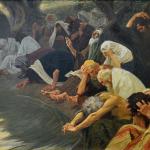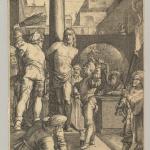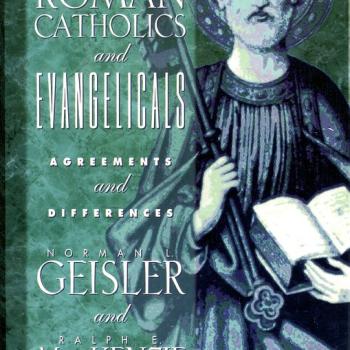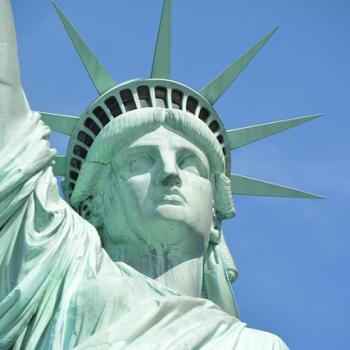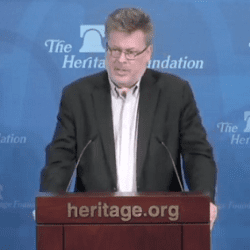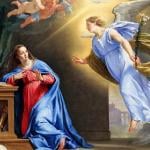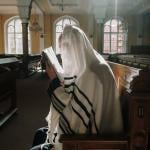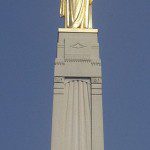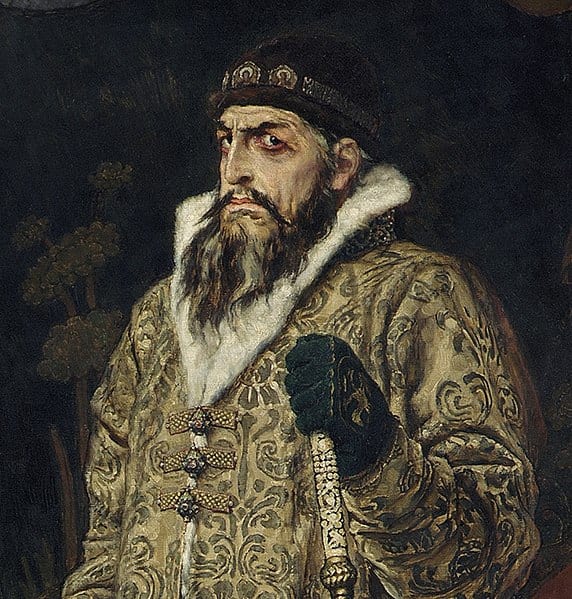
1) Encyclopædia Britannica, 1985, vol. 2, pp. 718-719, “Caesaropapism”:
Political system in which the head of the state is also the head of the church and supreme judge in religious matters. The term is most frequently associated with the late Roman, or Byzantine, Empire. Most modern historians recognize that the legal Byzantine texts speak of interdependence between the imperial and ecclesiastical structures rather than of a unilateral dependence of the latter; historians believe also that there was nothing in the Byzantine understanding of the Christian faith that would recognize the emperor as either doctrinally infallible or invested with priestly powers. Many historical instances of direct imperial pressure on the church ended in failure . . . John Chrysostom and most other authoritative Byzantine theologians denied imperial power over the church.
It was normal practice, however, for the Eastern Roman emperor to act as the protector of the universal church and as the manager of its administrative affairs . . . Emperors presided over councils, and their will was decisive in the appointment of patriarchs and in determining the territorial limits of their jurisdiction . . .
Caesaropapism was more a reality in Russia, where the abuses of Ivan IV the Terrible went practically unopposed and where Peter the Great finally transformed the church into a department of the state (1721), although neither claimed to possess special doctrinal authority . . .
2) Oxford Dictionary of the Christian Church, edited by F. L. Cross and E. A. Livingstone, Oxford University Press, 2nd edition, 1983, “Caesaropapism,” p. 218:
The system whereby an absolute monarch has supreme control over the Church within his dominions and exercises it even in matters (e.g. doctrine) normally reserved to ecclesiastical authority. The term is most generally used of the authority exercised by the Byzantine emperors over the Eastern patriarchates, especially in the centuries immediately preceding the Schism of 1054.
3) The New International Dictionary of the Christian Church, edited by J. D. Douglas, Grand Rapids, Michigan: Zondervan, revised edition, 1978, “Caesaropapism,” p. 173:
A system whereby supreme authority over the church is exercised by a secular ruler, so that even doctrine is subject to state control. The term is applied chiefly to the authority exercised by the Byzantine emperors over the Eastern Church during the sixth to tenth centuries. Similar terms are ‘Byzantinism’ and “Erastianism.’
4) A History of Christianity: Vol. 1: to A.D. 1500, Kenneth Scott Latourette, San Francisco: Harper & Row, revised edition, 1975, pp. 283, 312, 340:
It will be seen that Justinian greatly accelerated a movement which had begun with Constantine for the domination of the Church by the Emperor and which made the Church an instrument of the state. This control of the Church by the Emperor, known as cæsaropapism, was so characteristic of the eastern continuation of the Roman Empire that it was also called Byzantinism. As we have suggested earlier, it was the continuation of the tradition of the pre-Constantinian Roman Empire by which the Emperor, among other titles, bore that of ‘pontifex maximus,’ or chief priest . . .
That tradition was strengthened in the sixth and seventh centuries by Justinian and other strong Emperors . . . They issued decrees on ecclesiastical matters. Although technically they had only the right of nomination, they often virtually appointed the Patriarch of Constantinople. No Patriarch could hold office without their consent. Until late in the eighth century elections to the Papacy were confirmed by them. The subordination of Church to state persisted and today is seen in the family of Orthodox Churches . . .
In the West the Empire waned and the Popes stepped in to take its place in preserving order while in the East the Empire continued and the leading Patriarch of that region, he of Constantinople, was overshadowed by the Emperor and the state. Even when men came to that Patriarchate from the civil service, as did Photius, they had been subordinates and not rulers and tended to conform to the tradition of cæsaropapism. There may be deeper but more subtle reasons, such as the distinction between the Roman and the Greek genius, the one practical, the other, in its later Neoplatonic form, stressing spirit at the expense of flesh. It will be recalled that Monophysitism, belittling the human element in Christ, had much greater vogue in the East than in the West. Whatever the reasons, the contrast was real.
Dr. Latourette was the Sterling Professor of Missions and Oriental History and Fellow of Berkeley College in Yale University.
5) A History of Christianity: Vol. II: A.D. 1500-A.D. 1975, Kenneth Scott Latourette, San Francisco: Harper & Row, revised edition, 1975, p. 974:
In Russia efforts of Nikon to make the Patriarchate preeminent failed and within a generation after his death Peter the Great allowed the office to remain unfilled and substituted for it the Holy Synod, completely a creature of the tsar. What is called Cæsaropapism was a fact.
6) The Making of Europe, Christopher Dawson, New York: Meridian Books, 1956 (originally 1932), pp. 109-110, 161, 163:
The true founder of the state church of the Eastern Empire was Constantius II, who was typically Byzantine alike in his passionate interest in theological controversy and in his belief in his imperial prerogative as the defender of the faith and the supreme arbitrator in ecclesiastical disputes . . . . This system met with vehement opposition from two quarters: from Athanasius, the great bishop of Alexandria, and from the West, where the doctrine of the independence of the Church was uncompromisingly maintained, above all by St. Hilary and Hosius, the famous bishop of Cordova.
Hence there arose the long schism between the West and the state church of the Eastern Empire, which was not terminated until the faith of Nicaea was re-established by an Emperor from the West . . . .
The primacy of the new Patriarchate [Constantinople] was explicitly based on its connection with the imperial government, as against the principle of apostolic tradition, on which the three great Sees of Rome, Antioch and Alexandria founded their authority. And its subsequent evolution was conditioned by the same principles. It developed as the centre of the state church and the instrument of imperial ecclesiastical policy. While Rome and Alexandria each possessed a distinct and continuous theological tradition, the teaching of Constantinople fluctuated with the vicissitudes of imperial politics. Its tradition was in fact diplomatic rather than theological, since in every dogmatic crisis the primary interest of the government was to preserve the religious unity of the Empire, and the Patriarchate became the instrument of its compromises . . . And as the state church had been semi-Arian in the days of Constantus and Eusebius, so it was semi-Monophysite with Zeno and Acacius, and Monothelite with Heraclius and Sergius . . .
These schisms themselves contributed to preserve the prestige of Rome in the East, since the defenders of orthodoxy from the days of Athanasius to those of Theodore of Studium regarded the papacy as the bulwark of their cause against the attempts of the imperial government to enforce its theological ideals on the Church . . .
The monastic party in the Eastern Church . . . had in the eighth century looked to Rome as their chief support in their struggle for the freedom of the Church against the Caesaropapism of the Iconoclast emperors.
Dr. Dawson was educated at Oxford and was a Professor in the Religion Department at Harvard.
7) The Patriarchs of Constantinople, Claude D. Cobham, Cambridge: University Press, 1911, pp. 7-8, 10:
It may be noted that ninety-five Patriarchs reigned for less than a year. Also that of 328 vacancies between A.D. 36 and 1884 140 were by deposition, 41 by resignation, 3 Patriarchs were poisoned, 2 murdered, 1 beheaded, 1 blinded, 1 drowned, 1 hanged, 1 strangled. In all 191: so that 137 only closed their term of office by a natural death . . .
Probably no series of men, occupying through nearly eighteen centuries an exalted position, claim so little personal distinction as the Patriarchs of Constantinople.
8) Christendom: A Short History of Christianity, Vol. 1, Roland H. Bainton, New York: Harper & Row, 1966, p. 119:
Ivan IV, in 1547, took the title of Czar or Tzar, derived from Caesar. Ecclesiastical independence of Constantinople was declared thereafter and the Russian Church came to have its own patriarch, who became increasingly subservient to the Czar. The more the connection with Byzantium was severed, the more the Byzantine pattern was transferred, and even exaggerated, for the term Caesaropapism applied better to Moscow than to Constantinople.
Dr. Bainton received his Ph.D. in history at Yale, and also a D.D. from Meadville Theological Seminary and Oberlin College, Dr. Theologiae from the University of Marburg, and Litt. D. from Gettysburg College. He was Titus Street professor of ecclesiastical history at Yale University.
9) Emerging Medieval Europe, A.D. 400-1000, Archibald R. Lewis, New York: Alfred A. Knopf, 1967, pp. 26-27, 102, 129-130:
The fifth century affected the Latin Church and the Greek Church quite differently. The Church in Constantinople and in the part of Europe that was ruled by Eastern emperors had to face two special problems, heresy and Caesaropapism . . . When persecution proved ineffective, such emperors as Zeno and Anastasius attempted compromise, ignoring Chalcedon and defying the wishes of Constantinople and the Greek areas in an attempt to hold their Empire together.
At the same time, fifth-century emperors in the East emphasized their roles as heads of the Church, a tradition they inherited from Constantine. They did not hesitate to remove from office those churchmen with whose policies and views they disagreed. Since they felt it necessary to conciliate Monophysite Syria and Egypt, they were especially concerned with controlling the Church, lest controversy split their Empire apart. Thus, they laid the foundations of the Caesaropapism that, in later centuries, was often to distinguish the Greek Church from the Latin Church in the West . . .
The Byzantine emperors maintained almost complete control over the Church during this era [Carolingian: 718-840]. It was Leo who, on his own initiative, promulgated the decrees that proclaimed Iconoclasm, while his son, Constantine V, did not hesitate to remove from office patriarchs and other high Church officials. He even called together Church conclaves that were completely uncanonical, to implement an extreme Iconoclast program . . . A little while later, when Iconoclasm was revived, its restoration was the work of emperors who imposed their views on a somewhat reluctant Church. Seldom in the history of the Church had there been a period in which Caesaropapism was as unrestrained as it was in the Byzantium of this period . . .
The ending of the schism . . . did not mean that the emperors in Constantinople were willing to modify Caesaropapism, as far as their own Eastern Church was concerned. Basil I and Leo the Wise showed this clearly. Although no emperor after the end of Iconoclasm in 843 meddled with doctrine, all made it clear that they were masters of their Church and expected to be obeyed by the hierarchy . . . By the early tenth century, the Eastern Church was under firm Imperial control, a fact that the Papacy was tacitly willing to recognize.
Dr. Lewis was educated at Princeton University, and was Professor of Medieval History at the University of Texas. He was also a Fulbright Professor in Egypt and a Fulbright Research Scholar in Belgium.
10) History of the Christian Church, Vol. II: Nicene and Post-Nicene Christianity: A.D. 311-600, Philip Schaff, Grand Rapids, Michigan: Eerdmans Pub. Co., 5th edition, 1910; reprinted in 1974, pp. 133, 135-138:
§ 26. The Emperor-Papacy and the Hierarchy
. . . this, in point of fact, took place first under Constantine, and developed under his successors, particularly under Justinian, into the system of the Byzantine imperial papacy, or of the supremacy of the state over the church . . . .
The emperors after Constantine . . . nominated or confirmed the most influential metropolitans and patriarchs. They took part in all theological disputes, and thereby inflamed the passion of parties. They protected orthodoxy and punished heresy with the arm of power. Often, however, they took the heretical side, and banished orthodox bishops from their sees. Thus Arianism, Nestorianism, Eutychianism, and Monophysitism successively found favor and protection at court. Even empresses meddled in the internal and external concerns of the Church. Justina endeavored with all her might to introduce Arianism in Milan, but met a successful opponent in Bishop Ambrose. Eudoxia procured the deposition and banishment of the noble Chrysostom. Theodora, raised from the stage to the throne, ruled the emperor Justinian, and sought by every kind of intrigue to promote the victory of the Monophysite heresy. It is true, the doctrinal decisions proceeded properly from the councils, and could not have maintained themselves long without that sanction. But Basiliscus, Zeno, Justinian I, Heraclius, Constans II, and other emperors issued many purely ecclesiastical edicts and rescripts without consulting the councils, or through the councils by their own influence upon them. Justinian opens his celebrated codex with the imperial creed on the trinity and the imperial anathema against Nestorius, Eutyches, Apollinaris, on the basis certainly of the apostolic church and of the four ecumenical councils, but in the consciousness of absolute legislative and executive authority even over the faith and conscience of all his subjects . . .
There were bishops who justified even the most arbitrary excesses of the Byzantine despotism in religion by reference to Melchizedek and the pious kings of Israel, and yielded themselves willing tools of the court. But there were never wanting also fearless defenders of the rights of the church against the civil power. Maximus the Confessor declared before his judges in Constantinople, that Melchizedek was a type of Christ alone, not of the emperor.
In general the hierarchy formed a powerful and wholesome check on the imperial papacy, and preserved the freedom and independence of the church toward the temporal power . . .
The Western church, as a whole, preserved her independence far more than the Eastern; partly through the great firmness of the Roman character, partly through the favor of political circumstances, and of remoteness from the influence and the intrigues of the Byzantine court . . . In the Catholic system the freedom and independence of the church involve the supremacy of an exclusive priesthood and papacy . . .
Dr. Schaff (1819-1893), a prolific and well-known Church historian, was educated at Tubingen, Halle, and Berlin, and was professor in the German Reformed Seminary at Mercersburg, PA (1844-1865) and Union Theological Seminary in New York (1870-1893). He edited the Schaff-Herzog Encyclopedia of Religious Knowledge (3 vols., 1884), the sets of patristic writings, Nicene and Post-Nicene Fathers (Series I, II, 28 volumes, 1886 ff.), and The Creeds of Christendom (3 vols., 1877). He founded the American Society of Church History and was an early ecumenist.
11) The Icon and the Axe: An Interpretive History of Russian Culture, James H. Billington, New York: Random House, 1966 (786 pages, with 160 pages of elaborate footnotes) , p. 67:
. . . Ivan the Terrible, the first ideologist to rule Muscovy, the first ruler to be formally crowned tsar, and the man who ruled Russia longer than any other figure in its history . . . In some ways Ivan can be seen as a kind of fundamentalist survival of Byzantium. Following his Josephite teachers, he used Byzantine texts to justify his absolutism and Byzantine rituals in having himself crowned in 1547 with the Russian form of the old imperial title. His sense of imperial pretense, formalistic traditionalism, and elaborate court intrigue all seem reminiscent of the vanished world of Constantinople. Yet his passion for absolute dominance over the ecclesiastical as well as the civil sphere represented caesaropapism in excess of anything in Byzantium . . .
12) The Historical Road of Eastern Orthodoxy, Alexander Schmemann [Orthodox], translated by Lydia W. Kesich, Chicago: Henry Regnery Co., 1963, pp. 198-199, 217, 220-223, 313-315, 318:
Byzantium can in no way be considered merely a completed and outlived chapter of Church history. Not only does it continue to live in the Orthodox Church, but in a sense still defines Orthodoxy itself, constituting its historical form . . .
In a sense the Byzantine period must be acknowledged as decisive in the history of Orthodoxy, as the age of crystallization of Church life. The modern Orthodox Church is — from the viewpoint of history — the Church of Byzantium, which has survived the Byzantine Empire by five hundred years . . . . .
It is clear that one cannot simply equate Byzantine theocracy with either the subjection of the Church to the state, or the subjection of the state to the Church (for which the medieval popes struggled), although both tendencies too often appear as its sinful distortions . . .
Against the background of this theory, in its own way great and beautiful, all the countless retreats and distortions that took place in reality now seem too ugly. True, no emperor will again dare impose heresy on the Church as Byzantine emperors from Constantine to Theophilus had done [referring to the period of the late 9th c. onward]. . . and the Church’s voice was to sound stronger than it had before . . .
But the completely arbitrary nature of state authority always remained an incurable sore in Church life; still worse was the almost equally complete acceptance of this arbitrariness by the Church hierarchy. It was as though, having isolated its dogmatic doctrine in an inviolable holy of holies, protected by vows and with the empire itself subjected to it, the Church no longer felt any limit to imperial authority. It was as though, having become completely Orthodox, the emperor could now do anything that suited him in the Church.
There are too many instances during these centuries of this arbitrary use of power, of capitulations of the Church, for even a simple enumeration to be possible . . . The Church as a whole accepted all this manipulation almost as if it were equitable. Not a single voice rose in defense of the Church’s essential freedom; apparently no one now felt keenly its mystical independence of the state, in whose name so much blood had been shed a hundred years before . . .
A curve could be traced, showing a gradually fading image of the patriarch side by side with the ever-increasing splendor of the basileus, as the Eastern emperors were called. And this is not accidental. It gives proof that the scales of unattainable harmony were inclined in the direction of imperial power.
It is important to emphasize that this painful weakness cannot be explained solely in terms of the government’s coercing the Church — in terms of the superiority of physical force, so to speak, as at the beginning of the constantinian union. This was an inner, organic weakness of the representatives of the Church. Their dual situation made them not just the victims but also the agents of their own destiny . . .
The tragedy of the Byzantine Church consisted precisely in the fact that it became merely the Byzantine Church, that it merged itself with the empire not so much administratively as, above all, psychologically, in its own self-awareness. The empire became for it the absolute and supreme value, unquestioned, inviolable, and self-evident. The Byzantine hierarchs — like the Russian, later on — were simply incapable of going beyond the categories of the sacred empire, of appraising it in the light of the life-giving freedom of the Gospel . . .
Muscovite Domination of the Church
Here lay the true tragedy of the Russian Church, for this victory of the theocratic dream, this upsurge of national and religious consciousness, turned into a triumph for the Moscow autocracy and contained not only Byzantine but Asian — Tatar — features as well . . .
We see this death of freedom first of all in the Church. The theocratic empire recognizes only one unlimited authority, the authority of the emperor; beside it the image of metropolitan or patriarch fades away and the voice of the church grows weaker . . .
The tragedy of Muscovite Orthodoxy reached its final limit under Ivan, whose reign completed the development of Russian theocracy . . . The victory of autocracy was stained with the martyr’s blood of Metropolitan Philip (1569); his accusation against Ivan the Terrible was the last general open accusation against the empire by the Church. ‘I am a stranger upon the earth and am ready to suffer for the truth. Where is my faith if I am silent?’
After him the Church kept silent for a long time. His successors, Cyril and Antony, were mute witnesses to Ivan’s acts, ‘Where are the faces of the prophets, who could accuse the kings of injustice? Where is Ambrose, who restrained Theodosius? Where is John Chrysostom, who exposed the avaricious Empress? Who defends his offended brother?’ To Kurbsky’s* questions, the Russian Church had no answer.
*[Note] Prince Kurbsky (1528-83), one of the most enlightened men in Muscovy, deserted to Lithuania. He was the author of famous epistles to Ivan the Terrible . . .
. . . the defeat of the Trans-Volgan movement, despite the political motives that complicated all these disputes, meant suppression of the spiritual freedom of the Church and of any recognition of its incompatibility with service exclusively to the state or society.
Fr. Alexander Schmemann (1921-1983) was an Orthodox theologian and dean (1962-1983) of St. Vladimir’s Theological Seminary in Crestwood, New York — the preeminent Orthodox seminary in America. He succeeded Fr. Georges Florovsky in that post (1950-1955), and was followed by Fr. John Meyendorff. His specialties were Church history and liturgical theology.
*****
The mentality of caesaropapism is logically prior to any particular socio-political milieu. It is the internal willingness to put the state above the Church, to bow to it where there is a conflict — especially in matters of Church authority. True, it is a subjective thing, and difficult to measure, but there is no question that this was a shortcoming of Eastern Christianity, over against the West, which centered ecclesial power in the papacy (and for that we are constantly chided by Orthodox and Protestant alike). Caesaropapism became a problem in Christianity after 313 with the conversion of Constantine, and was especially influenced by the reign of the Emperor Justinian (r. 527-565).
Sure, the West has had periods of political intrigue and puppet-popes (we being human and sinners too), but the fact remains that the West has long excelled in “speaking truth to power,” due in particular to the papacy and the notion that the pope has jurisdiction over the whole world. This is quite evident today, with regard to John Paul II and Communism. It flows from the very nature of Catholic ecclesiology. It was always intended to be ultimately distinct from the state, whereas for the Byzantines, the two were almost inextricably linked, with (oftentimes) ill results.
Orthodox polemicists often try to explain the papacy and the form of Catholic ecclesiology and theology by purely socio-political analysis, as if the Christian Church (however one may define it) can be reduced to secular terms and categories and criteria. Everyone knows how sin can easily enter into Church affairs — in all parties. But the marvelous thing is how Rome managed to find its way through every time; how it uniquely preserved the faith without ever embracing heresy.
I have often thought that Eastern Christians too easily fall into this political analysis of the papacy because that is how they too frequently view their own ecclesiology — it being historically so wrapped up in caesaropapism and later, nationalism. This is common knowledge as a shortcoming in Orthodoxy, and is plainly admitted as such by anti-Catholic Orthodox polemicists like Franky Schaeffer.
So because this has been such an incessant problem in the East, when the West is attacked, the same analysis is used, as if the papacy evolved by pure historical happenstance and coincidence, rather than as a result of divine commission and will (Matthew 16 et al), as we believe. We hear talk of the Franks and so forth, as if this determined the shape of the papacy. What determined it was biblical revelation, and statements from our Lord Jesus, yet I rarely see the texts we bring to bear on the subject faced straightforwardly by Orthodox. I think that is a shame because we all agree that Holy Scripture is an objective criteria of orthodoxy.
Caesaropapism — it should be stressed — is not officially sanctioned in authoritative Orthodox dogma, doctrine, or canons, but it is an overriding fault — far more so than in Catholicism, and the West, before the Schism. I don’t think this is an arguable point. But historical reality is always much more complex, surprising, and fascinating than short — oftentimes significantly biased presentations of it.
We Catholics have our faults, too. The Crusades often degenerated into massacres and illegitimate power-hungry endeavors (though not with papal approval — it can be shown). Anti-Semitism was rampant. The Sack of Constantinople in 1204 is a huge black mark (though also done without papal approval at all). But Catholics — by and large — don’t deny these things in Western Christian history. Nor should the Orthodox deny or minimize the flaws which I critique presently. Both sides need to be honest about their past. We readily observe the pope talking about all sorts of unfortunate occurrences in Catholic history. Where do we see that in Orthodoxy?
I am positing a general tendency, in broad, general terms, much as, e.g., Metropolitan Ware himself did (in a much more limited way), and similar to what my sources claim, especially the well-known Orthodox theologian Fr. Schmemann. My approach is more or less an amateur “history of ideas/theology” outlook, which isn’t pretending to be an exhaustive treatment of all periods of Eastern, Byzantine, and Orthodox history, with the exactitude and precision of a professional historian. My purpose is not at all to run down Orthodoxy and Byzantium as bad through and through. No; my beef is with how the theories and ecclesiologies ultimately worked out in history.
But if Kallistos Ware and Alexander Solzhenitsyn can generalize about historical trends and tendencies, so can I (neither of them being historians, either, as far as I know — though they are obviously well-versed in history). Here is what they wrote:
Metropolitan Kallistos (Timothy) Ware commented on the situation which ensued after the fall of Constantinople, and which has been a problem ever since in Orthodoxy:
The things of Caesar now became more closely associated with the things of God than they had ever been before.” He admits that there is “a sad confusion between Orthodoxy and nationalism . . . the effects of this confusion continue to the present day. (The Orthodox Church, New York: Penguin Books, rev. 1980, p. 98)
In Constantinople, under Turkish rule, this led to, according to Ware:
. . . the Church’s higher administration being caught up in a degrading system of corruption and simony . . . the bishops fell a prey to ambition and financial greed . . . Patriarchs were removed and reinstated with kaleidoscopic rapidity . . . The extreme insecurity of the Patriarch naturally gave rise to continual intrigues . . . and the leaders of the Church were usually separated into bitterly hostile parties. (Ware, ibid., pp. 98-99)
Note how Metropolitan Ware makes a connection from the Ottoman period to “the present day.” It is a tendency which many Orthodox admit has lasted throughout Orthodox history as a glaring fault. The following section in his book (which comes between the two portions above) shows how he was intending to make a definite historical connection:
The Orthodox Church therefore became a civil as well as a religious institution: it was turned into the Rum Millet, the ‘Roman nation.’ The ecclesiastical structure was taken over in toto as an instrument of secular administration. The bishops became government officials . . . This situation continued in Turkey until 1923, and in Cyprus until the death of Archbishop Makrios III (1977).
The millet system performed one invaluable service: it made possible the survival of the Greek nation as a distinctive unit through four centuries of alien rule. But on the life of the Church it had two melancholy effects. It led first to a sad confusion between Orthodoxy and nationalism. With their civil and political life organized completely around the Church, it became all but impossible for the Greeks to distinguish between Church and nation. The Orthodox faith, being universal, is limited to no single people, culture, or language; but to the Greeks of the Turkish Empire ‘Hellenism’ and Orthodoxy became inextricably intertwined, far more so than they had ever been in the Byzantine Empire. The effects of this confusion continue to the present day. (Ware, ibid., p. 98)
So, as can be plainly seen, the point was entirely Metr. Ware’s, not some foreign, overzealous, fanciful, out-of-context interpretation of my own.
The great Russian Orthodox literary figure and dissident Alexander Solzhenitsyn rebuked Patriarch Pimen of Russia in his Lenten Letter of 1972, for his compromises with the atheist Communists:
A study of Russian history of the last centuries convinces one that it would have proceeded incomparably more humanely and harmoniously had the Church not renounced its independence and had the people heeded the Church’s voice, as for example occurred in Poland [a Catholic country] . . . A Church ruled dictatorially by atheists — this is a spectacle unseen in two thousand years. Given over to the atheists’ control is also the entirety of the operational management of the Church and the allocation of Church funds . . . Do not let us suppose, do not make us think, that for the bishops of the Russian Church temporal power is higher than the heavenly one, that earthly responsibility is more awesome than accountability before God . . . It was no easier in the early days of Christianity, which nevertheless prevailed and flourished. It showed us the way: sacrifice.
I ground my critique not so much in ideals and dogma, as in concrete historical reality and certain shortcomings and sins (as Ware’s and Solzhenitsyn’s cited comments also did). I maintain that there was and is a qualitative difference between the East and the West. We have plenty of historical faults, too: sins of commission, as I acknowledged above. But those things are for another discussion.
This is not an argument about the obvious difficulties of living under foreign rule — no one would deny that (and we here in the U.S. can hardly comprehend such an existence, so we cannot judge in a large sense). Rather, it is an acknowledgement that such a state of affairs falls far short of the Christian ideal, in terms of how the clergy relate to the state, and how the laypeople regard the Church and distinguish it from the state.
That was the whole point of Solzhenitsyn’s words. He went straight to the point of what the Church should be — that sacrifice would be required. He referred to the early Church, and we all know that means martyrdom. He speaks of centuries of Russian history. It is a very broad perspective, just as mine is. He doesn’t relegate the state of the Church in Communist Russia to some sort of “ecclesiological impossibility,” as if the Church couldn’t have resisted — hard as that would be. Rather, he assumes that it can and should resist. Likewise, under the Ottoman Empire. But in both cases the Orthodox Church (for the most part) didn’t do what it should have done. Orthodox may protest, “but it was impossible.” That isn’t what Solzhenitsyn thinks. That isn’t what the early Christians thought. They died for their cause.
I’m concerned about the historical prevailing attitudes of the Orthodox people, just as Ware describes them. It even goes beyond caesaropapism, I suppose, to a sort of servile, slavish following of the state as if it were higher than the authority of the Church. Orthodoxy “officially” repudiates this, yet it goes on for hundreds of years? Why that is, is the interesting question to ponder in this discussion. And earlier there were dozens of unbroken years in the major patriarchates where heresy was condoned and promulgated at the highest levels of authority — indeed, in the entire Empire on at least two occasions. None of this happened in the West.
Metr. Ware writes: (p. 49 in the 1980 edition of The Orthodox Church):
Admittedly there were many occasions on which the Emperor interfered unwarrantably in ecclesiastical matters . . .
My critique deals with actual, historical shortcomings, and not dogma (though the latter is related to the former in some definite fashion, as I would argue), so my point is backed up here by Metr. Ware, as well as the many other citations above.
Metr. Ware goes on (on the next page: p. 50) to analyze the situation during the period:
[I]n particular the Byzantines often fell into the error of identifying the earthly kingdom of Byzantium with the Kingdom of God, the Greek people with God’s people. Certainly Byzantium fell far short of the high ideal which it set itself, and its failure was often lamentable and disastrous. The tales of Byzantine duplicity, violence, and cruelty are too well known to call for repetition here. They are true — but they are only a part of the truth. For behind all the shortcomings of Byzantium can always be discerned the great vision by which the Byzantines were inspired: to establish here on earth a living icon of God’s government in heaven.
In some ways, Metr. Ware is more critical of his own Church than I am, as the outside observer. If indeed Orthodox ecclesiology helps to produce caesaropapism, the Catholic (not surprisingly) would say it is due to the rejection of papal primacy and supremacy and headship. Orthodox ecclesiology — lacking the papacy, and also ecumenical Councils for 1200 years — tends to lead to such a state of affairs almost despite itself, just as Protestant ecclesiologies and notions of authority (sola Scriptura, private judgment, etc.) inexorably lead to situations (sectarianism, theological liberalism, super-pietism, etc.) that the best Protestant exponents and minds would eschew as foreign to legitimate, “Reformational” Protestantism (whatever that is).
Such analyses are highly subjective and difficult to prove in an undeniable or purely logical fashion. The Orthodox would argue (I assume) that these shortcomings are entirely foreign to Orthodox ecclesiology — pure corruptions, whereas I would submit that they flow to some extent from Orthodox ecclesiology, regarded (from the Catholic point of view) as deficient in the expected manner. I maintain that the papacy is the way in which such historical shortcomings are more easily avoided. And we would say that that is not because of purely political or cultural elements (as is the usual charge), but because the papacy is divinely ordained as the very means of obtaining and preserving doctrinal unity in the Church and a proper notion of Church-above-state. We maintain that the actual course of history demonstrates that the Catholic Church (including the “West” pre-1054) has more successfully avoided both heresy and caesaropapism.
And many Orthodox today recognize this implicitly — to some small degree — by acknowledging that Petrine primacy is indeed a good and needed thing. The details are controversial, of course, but the mere fact of the continuing notion of such a primacy amongst some Orthodox is testament that there is something in Catholic ecclesiology which Orthodoxy lacks — just as the Vatican II emphasis on conciliarism and the laity was welcomed among Orthodox observers, as more in line with Orthodox ecclesiology. So we both continue to grow and learn: hopefully in the direction of further union.
I am not arguing that “the results of X-system (i.e., Orthodoxy) are corrupt, therefore X-system is false and corrupt through-and-through.” Rather, it is an analysis which I have coined “reverse pragmatism.” Orthodox ecclesiology isn’t untrue simply because Orthodox have fallen short, any more than the same could be said for Catholicism (God help us if our historical shortcomings were held against us!).Rather, I am contending that because there are inherent flaws in Orthodox ecclesiology (i.e., no papacy and no continuing ecumenical conciliarism), therefore, certain historical faults and excesses and unfortunate tendencies flow from the original error. That is, we can make the following propositions:
1. X is true because it works (this is pure philosophical pragmatism, which I would categorically reject).
2. X works because it is true (I call this the “reverse pragmatic argument” and I think it is a truism, especially where God’s guiding hand is concerned).
Likewise,
3. X is untrue because it doesn’t “work” (also pragmatism, and to be rejected by a Christian philosopher).
4. X doesn’t work because it is untrue (this I would accept with regard to Orthodoxy, but qualified in the following sense):
Conclusion:
Actual, historical Orthodox understanding of the proper relationship of Church and state doesn’t “work” as it should, not because of a formal, doctrinal, dogmatic Orthodox statement of caesaropapism, but rather, (to some undetermined extent) because of inherent deficiencies in Orthodox ecclesiology (which isn’t all bad, but simply lacking the “fullness” which Catholic ecclesiology possesses).
I’m sure this will go over like a lead balloon amongst Orthodox, but I’m entitled to my opinion, and it seems to me that both parties are free to speculate as to why caesaropapism has been such a problem in the East. This is my hypothesis as to at least partial causation. What is the Orthodox explanation? Even Fr. Schmemann comes close to such an analysis (in a limited sense) when he writes (cited above):
[T]his painful weakness cannot be explained solely in terms of the government’s coercing the Church . . . This was an inner, organic weakness . . . agents of their own destiny . . . it merged itself with the empire . . . psychologically, in its own self-awareness.
Now, Schmemann, admirably honest and “ecclesiologically self-critical” as he is, goes very far in his analysis, but doesn’t quite get to the next obvious question as to why this might be. I take it to the next step and contend that some of the blame might be plausibly connected to Orthodox ecclesiology itself — therefore it might be construed indirectly and partially as a “dogmatic problem” in addition to a “sin problem.” I think that we can safely conclude that Catholics are just as much sinners as Orthodox are, yet caesaropapism has been largely avoided in the West. So to explain that difference, it seems plausible to introduce dogmatic and ecclesiological considerations, as plain sin itself seems to inadequately account for the striking differences.
Note my qualifiers throughout. I am not making any blanket statements; simply speculating, and I think my thesis is as plausible as any countering Orthodox thesis might be as to the “why” of the historical events which have occurred. There are — no one can doubt — many similar types of criticisms made by Orthodox polemicists about my Church, whether it is the so-called “decisive” historical effect of the Franks, or the predestinarianism of St. Augustine, or the alleged “hyper-rationalism” of St. Thomas Aquinas, or the controversies over Divine Energies, the filioque, leavened bread in the Eucharist, and on and on.
We are analyzed in such terms all the time. Is it not proper for us ever to turn the tables, and that in (hopefully) a limited, super-qualified and relatively gentle manner? True ecumenism isn’t a mealy-mouthed, luvvy-duvvy enterprise of minimizing differences. True brothers can be honest about the differences, while at the same time exercising love and all due respect. I would even go further and say that true brotherhood and love demands such critical honesty. So I offer my analysis in love rather than condemnation and any desire to distort or slander.
Catholics don’t even have the freedom to be “anti-Orthodox” in the analogous sense. We are formally committed (Vatican II and many encyclicals) to accept all Orthodox (and trinitarian Protestants) as brothers in Christ, based especially on baptism, but also on much more common ground, wherever it exists. I have a great deal of respect for Orthodoxy and my Orthodox brothers and sisters. I don’t regard my critiques as at all contrary to that respect and admiration. Even Peter and Paul, and Paul and Barnabas argued vigorously, but I don’t think that proves that they didn’t love or respect each other.
To reiterate: I am not talking about sin per se (peccability, temptations, sexual immorality, greed and corruption and all the rest), but ideas (which caesaropapism is) which come from somewhere, according to the maxim, “ideas have consequences.” Sin is everywhere, and all-pervasive. Protestants have plenty of scandals in their own history (which I have documented, precisely because they make this unfair accusation against us). If they wish to take on my belief-system on that double-standard ground, I am more than willing to play that game, for the sake of revealing its utter inadequacy as a disproof (and indeed I have done so).
Much more interesting to me, however, is the question “why did caesaropapism prevail much more so in the East than in the West?” If any Orthodox can explain that more plausibly to me than my attempt, I would be most grateful to them. But at least I have taken the debate to the level of root causes, whatever one may think of my particular hypothesis. I am always a “radical” in that sense — going to the roots, which is the meaning of “radical.” I went to the roots of development of doctrine, and that made me a Catholic. I am always interested in history, Church history, history of doctrine, and history of ideas, so this discussion touches on many aspects of that.
1. Since my argument is based on the interpretation of (Church) history and the influence of ideas upon doctrine and behavior, the “why’s” of history, and a summation of the Eastern view on Church and State for some 1500 years, over against the Western, secondary sources are pretty much inevitable, by the nature of the case. The primary sources would usually not deal with such questions and analyses. They are too “immersed” in the situation (like a fish in water) to be able to offer such an analysis, which comes from the long perspective of history itself.
2. I am not interested in a million particular historical examples of caesaropapism (neither, I suspect, would readers of whatever persuasion be). Likewise, I have less than no interest in, e.g., 100 proofs that the Prussians tended to be militaristic, as opposed to why they were. Rather, I go to the historian (as a layman myself) to summarize the historical data. That is their job. I don’t wish to do their job (I have enough to do), but rather, to benefit from their expertise and knowledge.
3. Historians’ expressed opinions are not worthless in and of themselves, if they lack an immediate extensive thesis on primary sources, numerous historical incidents, etc. That would reduce to absurdity. Is, e.g., the Encyclopedia Britannica (which I cited) useless because it offers summaries, by its very nature and purpose? Also, Fr. Schmemann’s work, which I cited, does not have extensive footnotes. He has very few; mostly simply documenting quotes from people such as Fr. Florovsky (none of which I utilized, except for one, I believe). So he is to be dismissed on those grounds? Summaries and overviews do fulfill a very important function. They save us all a lot of time and effort. I am not writing for historians, but for the general public (at least those who have some interest in theology, history, and perhaps philosophy).
4. I am not, and have never claimed to be, a professional historian. I have dealt with this issue in the past, both with regard to theology and even issues such as the theory of evolution, and I have defended my methods vigorously. It seems self-evident to me that I don’t have to be an historian myself in order to make a case based on citations of professional historians. I don’t see this as arguable. One makes their argument, and they (if needs be) bring in the experts in various fields to back it up. Some people seem to espouse what I would call an “elitist” position and argue that one has no right to engage in historical analysis unless they have advanced graduate degrees in history (or at least use the same exact methodology as professional historians). They cannot — for some strange reason — simply allow one the “luxury” of citing the historians’ summaries to bolster their own case.
5. Besides, the people I cite are all historians, so if a dialogical opponent wishes to do historiography per se, then they can take them on, not myself. Let them do “academic battle” with their fellow comrades, and dispute their summaries if they wish — more power to them. I would love to see that. Such erstwhile critics can deal with Dawson and Schaff and Latourette and Schmemann himself (and any more recent historians who might take the same view). At least that would be a “fair fight” — not requiring an admitted non-historian to fight on the same ground that the historian does in their own academic field. I may have “violated” in the eyes of historian critics some tenets of historiographical “dogma,” but I have not surpassed the boundaries of reason or logic or philosophy in my writing.
6. I often see — in the course of my website and apologetic labors — a tendency for some people to gripe about citations, rather than actually interact with them, which is the easy way out (if I can be cynical for a moment, in my frustration). Rather than actually consider the citations, such people prefer to digress into tiresome methodological disputes. I see this (in part) as a symptom of the excessive compartmentalization of knowledge today, which I have often noted (and that is somewhat in my area — I majored in sociology). A trained historian would usually demand (perhaps subconsciously) the same academic rigor in historical matters of mere laymen such as myself. But this is unreasonable, irrational, and unfair, per the above reasoning.
7. Another tired objection is the “out-of-context” mantra. One hears that from opponents of all stripes when they disagree with something. Of course, it may be true, even frequently, I readily grant. But all the time? I think not . . . In any event, I think the citations speak for themselves as to the historical reality. If someone wants to dismiss all these historians on such hair-splitting elitist academic grounds, they are free to do so, but (with all due respect), I think it is simplistic and evasive, myself: methodology emphasized to the point of absurdity and at the expense of content altogether.
8. The reader will note that I freely included “anomalous” statements that qualified and minimized the tendencies under present consideration. If I were out to polemically make my case at all costs, or to misrepresent anyone, or paper over historical complexities, or special plead as a “triumphalist” Catholic, surely I wouldn’t have done that. But I am interested in the truth of history, first and foremost, so I cite whatever is there (whatever I could find in my own library), and whatever is relevant to the discussion.I was fair in my citations — not omitting things which might be regarded as contrary to my “case.” But there is plenty to solidly establish my point of view.
9. Credentials of authors are also important, and not to be despised as irrelevant. Every book does the same (and many articles as well), so it is not like it is some sort of novelty. My point was: these guys are historians — many quite eminent and credentialed; this is what they think. How would an opponent dispute their contentions? Such critics of my particular methodology demand of me hours and hours of further research and exact historiographical method, before they will even “condescend” to answer me. I must say that this is a tremendous disincentive for the layman (in this case, in history) to continue at all, for I have no more desire than anyone else to spend dozens of hours of my time on a point I think is hardly disputable.
***
For related reading, see my Eastern Orthodoxy web page.
***
***
(originally posted in 2000)
Photo credit: Tsar Ivan The Terrible [1530-1584] (1897) — cropped –, by Viktor Mikhaylovich Vasnetsov (1848-1926) [public domain / Wikimedia Commons]
***


